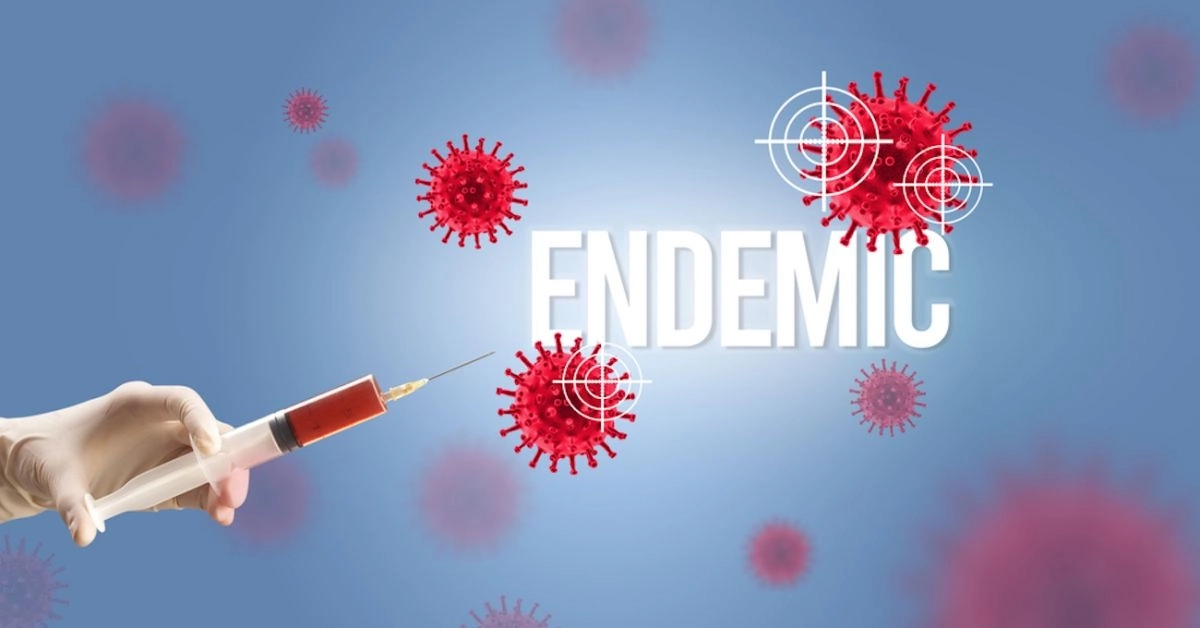An endemic is a disease that afflicts a group of people in a country or a region of the world. The number of people that have contracted that type of disease is higher than in other areas.
Endemics are usually confined to one region, country, or area. Malaria is endemic to parts of Africa; opioid addiction is endemic to certain areas of America.
Endemics are constantly maintained at a baseline in a population. This means that outbreaks may occur, but those outbreaks can be managed. It may always be present but it can still be managed without it becoming pandemic.
Endemic Vs Pandemic Vs Outbreak Vs Epidemic
Endemics, pandemics, outbreaks, and epidemics are often confused for one another. And it’s easy to understand why: even the words endemic, pandemic, and epidemic sound the same!
Yet, there are very important distinctions between these four terms. Endemics may lead to outbreaks, and outbreaks may lead to pandemics.
What’s a pandemic?
A pandemic is a disease that affects a large region of the world and a large number of people.
When the COVID-19 virus left China and affected multiple countries, it gained pandemic status. Though the disease is still prevalent across the world (and is expected to maintain its pandemic status for the time being), it may drop to endemic status as vaccination, tracking, and social distancing continues.
Infamous previous pandemics include the Spanish Influenza, the AIDS pandemic, and H1N1 Swine Flu.
Since all of these diseases affected vast regions, spanning across the world, they were labeled as pandemics. They are now labeled as epidemics or endemic diseases.
What’s an outbreak?
An outbreak happens when a larger than average expected number of patients are infected with a disease.
According to the World Health Organization (WHO), outbreaks are transmitted through:
- Person-to-person contact
- Animal-to-person contact
- The environment
- Other media
Person-to-person is the form of transmission we’re probably most familiar with. This is when a disease is spread through person-to-person contact, such as passing bacteria through touch, saliva droplets, or another form of contact.
Animal-to-person contact is how the novel started before it was spread from person to person.
Some diseases are caused by contact with organic materials, including minerals. In some cases, the origins of diseases are unknown.
What’s an epidemic?
Epidemics are diseases that are widespread throughout a particular community. Diseases may gain epidemic status when there is a sudden sharp influx of cases.
The number of increased cases may vary from disease to disease, as many diseases are extremely rare and only warrant a small number of cases (even merely one) to be considered an epidemic.
Since polio was eradicated in the U.S. in the late 1970s, only one case of this disease may garner an epidemic investigation. Similarly, smallpox was eradicated in the 1980s, so even one case of polio found anywhere in the world would lead to an epidemic investigation.
Is COVID endemic?
No. COVID-19 is currently still classified as a pandemic.
But since it isn’t confined to one geographical region, it’s considered endemic. When the virus was only affecting Wuhan, China, it was endemic to Wuhan; but when it spread to other areas of the world, it became a pandemic.
Though, some experts believe it may garner endemic status one day. Once the number of infections decreases and the disease is considered to be contained within one area of the world, it may read endemic status.
Hopefully, (someday) we will see COVID-19 eradicated similarly to how polio was eradicated in the U.S. and smallpox was eradicated throughout the world.
What's a disease?
A disease is a disorder found in living things, including humans, animals, and plants that weren’t caused by physical injury.
Diseases may be caused by a variety of factors, and there are four types of diseases, including:
- Infectious
- Deficiency
- Hereditary
- Physiological
Infectious diseases (such as COVID) are transmitted from person to person, plant to person, or environment to person. Deficiency diseases are caused by vitamin or mineral deficiency (scurvy is a deficiency of vitamin C).
Hereditary diseases are passed down from parent to child (and include both genetic and non-genetic hereditary diseases).
Physiological diseases are caused by a malfunction in the body (diabetes is a malfunction of the body’s blood glucose system).
Disease Outbreak Causes
The causes of diseases vary greatly from the causes of outbreaks.
While diseases are often caused by infections, deficiencies, hereditary factors, and physiological malfunctions, outbreaks are often caused by weather patterns, exposure to chemicals or radioactive materials, and environmental disasters.
Weather
Weather patterns may cause outbreaks of certain diseases.
Many diseases are more prevalent in the colder months when it’s more common to be indoors with others and air circulation is lower.
Measles often appears more in the later winter and early spring months in parts of the world where winters are colder; in the tropics, measles is more prevalent during rainy seasons.
Global warming may also have an effect on disease outbreaks, as this phenomenon has been the cause of changes in weather patterns.
Exposure
Disease outbreaks may also be the result of exposure to certain chemicals or radioactive substances.
Since some diseases are caused by exposure to minerals or other organic materials, an outbreak may occur after widespread exposure.
Radiation may cause cancer, hypothyroidism (also called underactive thyroid disease), and parathyroid adenoma. Exposure to mercury may cause acrodynia (pink disease) or Minamata disease.
Environmental Disasters
Environmental disasters may lead to disease outbreaks, too.
While these disasters themselves may not always be the direct cause of outbreaks, disasters may lead to circumstances that increase the outcome of disease transmission. These circumstances may lead to water supply and food chain shortages. They may also lead to poorer air quality and disrupt sanitation services.
All of these factors may lead to disease outbreaks, as the water supply, food chain, air quality, and sanitation systems help to keep diseases at bay.
Just some factors that may lead to disease outbreaks may include chemical and toxin releases, new pathogens, and over-exposure to radiation, chemicals, and certain minerals.
Types of Endemics
There are many diseases endemic to different areas of the world. A few of the most common endemics are chickenpox, malaria, and HIV.
Both HIV and chickenpox are caused by person-to-person transmission. Chickenpox is transmitted between patients that have not been vaccinated or that have never had the disease.
Malaria is a disease caused by mosquito bites (animal-to-person transmission).
Chickenpox
Chickenpox is possibly one of the most well-known endemics, as this disease is very common (and often mild).
According to Boston Children’s Hospital, “More than 95 percent of American adults have had chickenpox and about 4,000,000 people get chickenpox every year.” That number may continue to dwindle as chickenpox vaccines are more widely available.
Malaria
Malaria is an endemic found all over the world, though according to the CDC, “The highest transmission is found in Africa South of the Sahara and in parts of Oceania such as Papua New Guinea.”
It is most common in subtropical and tropical areas, though not in areas of high altitude, during colder months, or in the desert.
Malaria is essentially a parasite transmitted by mosquitoes, so this disease is more common in areas of the world where both the parasite and mosquitos are abundant. There are drugs available to prevent malaria (malaria pills) for travelers planning on spending time in areas where malaria is more prevalent.
How to Avoid Getting Sick
Despite the number of disease outbreaks, endemics, and pandemics known to humans, there are ways to mitigate the possibility of getting sick.
Modern medicine has offered us a variety of methods to avoid getting sick — and to treat illnesses once they arise.
Get Regular Check-Ups
Getting regular check-ups is one way to mitigate the risk of getting sick.
Even though your doctor may not be able to wave a wand and prevent you from contracting COVID or the flu, your doctor can help you pinpoint possible risk factors (such as attending large indoor events or exposing yourself to sicker people).
Patients that visit a doctor regularly may be more likely to trust medical professionals in general. Getting regular check-ups allows you to develop a rapport with your doctor and receive tailored medical advice.
People that trust medical professionals are also more likely to follow through with treatment plans.
Use Proper Hygiene
While COVID has forced us to take a long hard look at how we practice proper hygiene, it’s not just the novel coronavirus that we need to consider.
Using proper hygiene may help to shield us from an array of viruses and bacteria. This may include:
- Avoiding touching eyes, hands, nose, and face
- Covering coughs and sneezes
- Sanitizing surfaces
- Using soap or hand sanitizer
- Washing hands
It’s especially important to wash your hands after using the bathroom, before eating, after sneezing or coughing, and upon entering your home. It’s recommended to wash your hands in cold or warm water with soap for at least 20 seconds.
Avoid Sick People
Germs may spread from person to person, person to surface to person, and through the air.
Airborne viruses may linger in the air for seconds to minutes. Germs and viruses may linger even longer on surfaces (especially metal or hard surfaces, depending on the particle).
If you want to avoid getting sick, avoid exposure to anyone that is exhibiting symptoms of sickness. Symptoms may include:
- Chills
- Coughing
- Fever
- Nausea
- Sneezing
- Sweating
- And more
Stay home if you’re showing signs of a cold or virus or other illness. If you need to see a doctor, you may want to schedule an appointment with a telehealth professional to avoid sicker patients in the waiting room.
Wear a Mask
While many of us started wearing masks because of COVID mask mandates, we found that they not only helped prevent the spread of COVID — but of other viruses and illnesses, too!
You may want to wear a mask if you’re worried about contracting COVID or any virus, illness, or disease. It’s important to remember that wearing a mask may not prevent or slow the spread of some diseases, but doing so may help to prevent the spread of the common cold, flu, and COVID.
The CDC recommends wearing certain cloth or disposable masks. According to the CDC, your mask should fit snugly on your face (with no gaps, vents, or valves). Masks should also be made of double-layered fabric or fabric that blocks light when “held up to a light source.”
Get Vaccinated
Your doctor can tell you which vaccinations you need at your physical each year.
COVID vaccinations are currently available at most pharmacies, many grocery stores, doctor’s offices, and urgent care centers. These vaccinations are free of charge at most locations (call ahead and ask about pricing before showing up for your appointment) through government assistance and/or health insurance.
You’ll also find COVID vaccination pop-ups throughout many towns and cities. If you’re eligible for a COVID booster shot, you’ll want to schedule an appointment to get one.
If you’re eligible for a flu shot, you may want to schedule one as recommended by your doctor.
Get Tested
If you believe you’ve contracted a disease, virus, or another type of illness, get tested (if there is a test available).
Testing is available for the flu, COVID, HIV, malaria, and myriad other illnesses. If you believe you’ve contracted a virus or illness, it’s important to get tested — and not to avoid your symptoms.

